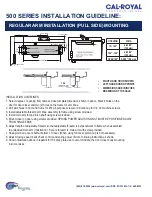
FABRICATOR 211i
SAFETY INSTRUCTIONS
SAFETY INSTRUCTIONS AND WARNINGS
1-6
Manual 0-5157
C Ventilation
!
WARNING
Ade quately ventilate welding, heating, and
cutting work areas to prevent accumula-
tion of explosive or toxic concen trations
of gases. Certain combinations of metals,
coatings, and gases generate toxic fumes.
Use respiratory protection equipment in
these circumstances. When welding/brazing,
read and understand the Material Safety Data
Sheet for the welding/brazing alloy.
D Personal Protection
Gas flames produce infrared radiation which may have
a harm ful effect on the skin and especially on the eyes.
Select goggles or a mask with tempered lenses, shaded
4 or darker, to protect your eyes from injury and provide
good visibility of the work.
Always wear protective gloves and flame-resistant clothing
to protect skin and clothing from sparks and slag. Keep
collars, sleeves, and pockets buttoned.
DO NOT
roll up
sleeves or cuff pants.
When working in a non-welding or cutting environment,
always wear suitable eye protection or face shield.
!
WARNING
Practice the following safety and operation
precautions EVERY TIME you use pressure
regulation equipment. Deviation from the
following safety and operation instructions
can result in fire, explosion, damage to
equipment, or injury to the operator.
E Compressed Gas Cylinders
The Department of Transportation (DOT) approves the
design and manufacture of cylinders that contain gases
used for welding or cutting operations.
1. Place the cylinder (Figure 1-1) where you will
use it. Keep the cylinder in a vertical position.
Secure it to a cart, wall, work bench, post, etc.
Figure 1-1: Gas Cylinders
!
WARNING
Cylinders are highly pressurized. Handle
with care. Serious accidents can result from
improper handling or mis use of compressed
gas cylinders DO NOT drop the cylinder,
knock it over, or expose it to excessive heat,
flames or sparks. DO NOT strike it against
other cylinders. Contact your gas supplier
or refer to CGA P-1 “Safe Handling of Com-
pressed Gases in Containers” publication.
NOTE
CGA P-1 publication is available by writing
the Compressed Gas Association, 4221
Walney Road, 5th Floor, Chantilly,VA 20151-
2923
2. Place the valve protection cap on the cylinder
whenever mov ing it, placing it in storage, or not
using it. Never drag or roll cylinders in any way.
Use a suitable hand truck to move cylin ders.
3. Store empty cylinders away from full cylinders.
Mark them “EMPTY” and close the cylinder
valve.
4. NEVER use compressed gas cylinders without
a pressure reducing regulator attached to the
cylinder valve.
5. Inspect the cylinder valve for oil, grease, and
damaged parts.













































